
The sense of knowing when one is being stared at is commonly reported, notably by police and other professionals involved in surveillance activities. Recent experimental investigations suggest that the phenomenon is real. This article describes experiments carried out by biologist Rupert Sheldrake and others.
The Sense of Being Stared At in Humans and Non-Humans
Have you ever turned round feeling that someone is looking at you from behind, finding that this is the case? Most people have had this experience at some point, as well as the experience of being able to make people turn around by staring at them.
This article shows that the sense of being stared at can be investigated in experimental tests both easily and inexpensively, and that there is now strong evidence that people really can tell when they are being looked at from behind. An acceptance of this evidence by the scientific community would have enormous theoretical implications, both for the theory of vision and our understanding of consciousness.
In surveys in Europe and North America, between 70% and 97% of the people questioned said they had had personal experiences of these kinds.1 In Britain, Sweden and the United States, questionnaires showed that more women (81%) than men (74%) said they had felt they were being stared at. This experience occurred most commonly with strangers in public places, such as streets and bars. Also, significantly more women (88%) than men (71%) said they had found they could stare at others and make them turn around.2
Curiosity was the most frequent reason for staring at others when they turned around, followed by a desire to attract the other person’s attention. Less frequently, the motives were sexual attraction, or anger. Some people found that looking with emotions such as distress, or affection, or good wishes could cause a person to turn.3
Some people observe others for a living. The sense of being stared at is well known to many police officers, surveillance personnel and soldiers, as Sheldrake found through an extensive series of interviews. When detectives are trained to follow people, they are told not to stare at their backs any more than necessary, because otherwise the person might turn around, catch their eye and blow their cover (see Sheldrake, 2003a for more examples involving celebrity photographers, military snipers and martial artists).
Non-human animals also seem able to detect looks. Sleeping dogs or cats can be woken by their owners, merely by staring at them. Even when hunters and wildlife photographers are hidden and looking at animals through telescopic lenses or sights, some are convinced that animals can detect their gaze, and, conversely, have said they have felt when they themselves were being looked at by wild animals.4
In another survey, 34% of adults and 41% of children said that they had felt when animals were looking at them.5 About half the respondents believed that animals could feel their looks, even when the animals could not see their eyes.
If the sense of being stared at really exists, then it must have been subject to evolution by natural selection. The explanation that Sheldrake finds most probable is that it evolved in the context of predator–prey relations. Prey animals that could detect when predators were looking at them would probably stand a better chance of surviving than those that could not.6
In spite of the widespread familiarity of this sense, until the late 1980s there was very little research on this subject, even by parapsychologists. There have only been five reports of experimental investigations between 1885 and 1985, including two in unpublished student theses. The three most recent gave positive, statistically significant results. Since the late 1980s, there has been an increase in research activity, which is reviewed below. Most experiments have given positive, statistically significant results supporting the reality of this sense.
Scientific Investigations from 1898 to 1985
Scientific research on this subject was started - and yet set back for decades - by two American psychologists, EB Titchener and J Edgar Coover. Both claimed to have shown that the sense of being stared at was illusory.
EB Titchener, one of the founding fathers of experimental psychology in the United States, published the first scientific paper on staring in Science in 1898. He was certain no mysterious influences could possibly be involved and proposed a ‘rational explanation’: people tend to turn round anyway; if by chance they see someone looking at them they remember it; if they do not, they forget it. Also, by turning round, their movement might attract the attention of someone behind them, so the two people might catch each other’s eyes.
Titchener reported that he had carried out experiments on students’ ability to detect stares and claimed they invariably gave ‘a negative result; in other words the interpretation offered has been confirmed’. He published neither experimental details nor data. Titchener’s paper was very influential, and is still cited by sceptics today.7
Another early American psychologist, JE Coover, was equally sceptical, but he was the first to publish methods and data.8 In his experiments, people worked in pairs; one was the subject, the other the looker. The subject sat with his back to the looker, who in a randomized series of trials either looked or did not look. In each trial, the subject guessed whether or not he was being looked at.
Again, Coover claimed his results showed there was no significant ability to detect looks, and concluded that popular belief in the sense of being stared at was ‘groundless’ (this will be discussed in greater detail below).
The next report in the scientific literature was in 1939, by JJ Poortman, in Dutch. Poortman found, using Coover’s method, he was right significantly more often than wrong in guessing when his woman friend was looking at him.9
After Poortman’s experiment, there was a gap of 39 years, before Donald Peterson carried out an experiment in 1978 as a student project at the University of Edinburgh. The looker sat in a closed booth separated from the subject by a one-way mirror, and was invisible to the subject. The results were positive and statistically significant.
Five years later, Linda Williams, a student at the University of Adelaide, Australia found a statistically significant effect when a person in a different room looked at the subject through closed circuit television.10
Recent ‘Direct Looking’ Experiments
Since the late 1980s, there has been an increase in research on the sense of being stared at, following two parallel approaches.
The first kind of experiment involves direct looking, using versions of the Coover procedure. People work in pairs, with a subject and a looker. In a randomized series of trials the subjects sit with their backs to the lookers, who either stare at the back of the subjects’ necks, or look away and think of something else. A mechanical signal marks the beginning of each trial. The subjects guess quickly, in less than ten seconds, whether they are being looked at or not. Their guesses are either right or wrong, and are recorded immediately. A test session usually consists of twenty trials, and takes less than ten minutes.
In the second kind of experiment, the looker and subject are in different rooms connected through closed circuit television (CCTV), as discussed below.
Direct-looking tests are far easier to perform than CCTV trials, and have now been carried out with many thousands of participants, both adults and children. Many tests have been conducted in schools. This research has been popularized through New Scientist magazine, BBC TV and Discovery Channel TV, and test procedures have been published on these organizations’ web sites, as well as on Sheldrake’s website, www.sheldrake.org, enabling numerous people to participate in this research. At least 20 student projects in schools and universities have involved staring experiments. Altogether, there have been tens of thousands of trials.11
The results are remarkably consistent. Typically, about 55% of the guesses are right, as opposed to 50% expected by chance. The smallness of the effect (5%) may be partly due to the “unnatural” nature of the task, given the phenomenon usually happens when we are not focusing on it. Nevertheless, repeated over tens of thousands of trials this result becomes astronomically significant statistically (Table 1).
An alternative way of analysing the results is to use a ‘sign’ test, which gives an equal weighting to each subject. Those who are more right than wrong have a positive (+) sign, and those who are more wrong than right a negative (–) sign. For this analysis, all those equally right and wrong are ignored. By chance, the number of people with positive and negative signs should be the same. As Table 1 shows, 853 people were positive and 466 negative, a result very significantly above chance (p = 1x10–20).
In experiments n which the same subjects were tested repeatedly and given trial-by-trial feedback, there was a striking learning effect, with a significant (p=0.003) improvement in scores with practice (Colwell et al, 2000). In a German school, with repeated testing, some 8 to 9 year-old children achieved accuracies as high as 90%.12
|
Y ear |
Trials |
Right |
% right |
N |
+ |
– |
p |
|
1998 |
3,240 |
1,843 |
56.8 |
160 |
97 |
42 |
3x10–6 |
|
1999 |
13,903 |
7,636 |
54.9 |
661 |
387 |
186 |
1x10–15 |
|
2000 |
4,800 |
2,544 |
53.0 |
294 |
150 |
94 |
.0002 |
|
2001a |
8,060 |
4,385 |
54.4 |
403 |
197 |
134 |
.0003 |
|
2002 |
800 |
441 |
55.5 |
40 |
22 |
10 |
.03 |
|
Total |
30,803 |
16,849 |
54.7 |
1,558 |
853 |
466 |
1x10–20 |
Table 1. Results of direct staring experiments, expressed both as percentages of correct guesses and in terms of signs. Subjects who were more right that wrong were scored +, those who were more wrong than right, –. The total number of subjects is shown in the column N. The p values refer to the probability using the chi-squared test), with the null hypothesis that the number of + and – signs are equal. The year column gives the dates of Sheldrake’s papers in which the results were published.13
This staring effect seems to be widely replicable. The data in Table 1 include the results from all of Sheldrake's 21 experiments, in twenty of which the outcome was positive. They also include the results from 37 independent investigations in schools and colleges. Thirty-six of these investigations showed a positive effect, but one did not. Sheldrake was notified of all these 37 investigations in advance, and included all the data from them. But he discarded all unsolicited data from other projects in the hope of removing the ‘reporting bias’, which refers to people only sending their positive results.
One student project showed that pairs of twins scored significantly higher at detecting whether they were being stared at than untwinned siblings or unrelated people.14
The NeMo Experiment
The largest experiment ever conducted on the sense of being stared at began in 1995 at the NeMo Science Centre in Amsterdam. By 2002, over 18,700 looker-subject pairs had taken part, with positive results that were astronomically significant statistically (p = 10–376).15
In the NeMo Centre the test is presented as a question: ‘Do you have eyes in the back of the head?’ The experiment is computerized. The subject sits about two metres in front of the looker, with his or her back to the looker. For each trial the looker is instructed whether to look or not by a signal on the computer screen, in a random sequence provided by a random number program. The signal for the beginning of each trial is given by a ‘trrrrrr’ tone lasting seven seconds, and the end of which the subject know the trial has ended, and guesses out loud whether he or she was being looked at or not. The looker enters the guess into the computer. Depending on the number of correct or incorrect guesses, after a maximum of 29 trials, the computer announces whether the subject has ‘eyes in the back of the head’ or not. This test is popular with children and their families.
The NeMo test was developed by Diana Issidorides, a cognitive psychologist, and Jan van Bolhuis, a statistician at the Free University of Amsterdam. The inbuilt statistical program is designed in such a way that if people guess at random, 20% would be classified as having ‘eyes in the back of their head’. Against this chance expectation of 20%, with data from 18,793 subjects, between 32% and 41%, depending on age and sex, had ‘eyes in the back of their heads’. The most successful subjects were boys under the age of 9.16
These tests were unsupervised, and there is no guarantee that some people did not cheat. Because this possibility remains open, the results can only be taken as an indication that test would be well worth carrying out under more controlled conditions.
Online Experiments
A version of the ‘direct staring’ test has been running on www.sheldrake.org since October 2002. The results have been astronomically significant statistically. But because the tests were unsupervised, there is no way of assessing their reliability. Nevertheless, this online method makes it very easy for anyone in the world who wants to take part in this research to do so. Indeed, there is now an online version of the experiment that uses webcam technology, meaning that the participants do not even need to be in the same room And this approach also allows for those who suspect others of cheating or being influenced by subtle sensory clues to carry out their own tests as rigorously as they like, or get their students to do them under supervised conditions.
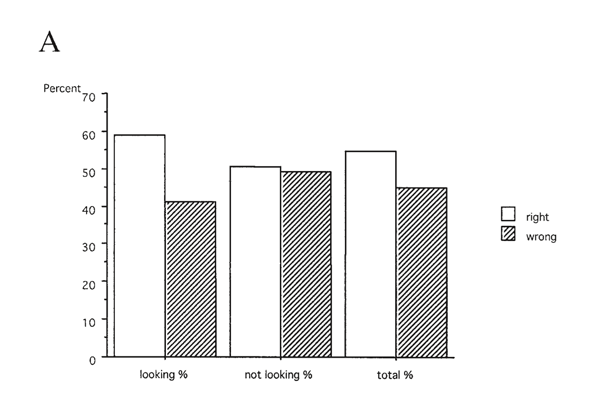
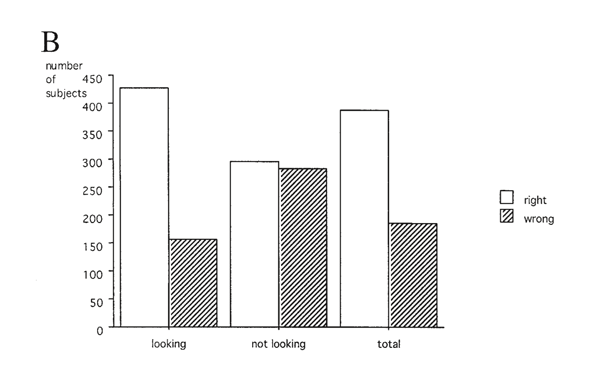
Figure 1. Combined results of experiments on the sense of being stared at carried out in Britain, Germany and the United States (data from Sheldrake (1999), Table 5).
A: The percentages of correct guesses in looking trials, not-looking trials and in total.
B: The number of subjects who were more right than wrong compared with those who were more wrong than right in looking trials, not-looking trials and in total.
A Distinctive Pattern of Results
There is no doubt that most of these staring tests give positive scores. But probing further, a distinctive pattern of results shows up again and again.
Typically, the percentage success rates in looking trials are above chance. In the not-looking trials they are at chance levels (Figure 1A). This pattern shows up even more clearly when the data are analysed using the sign method (Figure 1B).
The pattern makes sense if people really do have a sense of being stared at from behind. The sense would operate when they are being stared at, giving positive scores in the looking trials. But in the control trials, no one is looking. The subjects are being asked to detect the absence of a stare, an unnatural request with no parallel in real-life conditions. Under these circumstances, subjects guess at random.
This characteristic pattern might imply that the results of the trials are not a result of cheating, subtle cues, implicit learning or errors in recording the data. These possible sources of error should have affected scores in both looking and not-looking trials, not just in looking trials.17
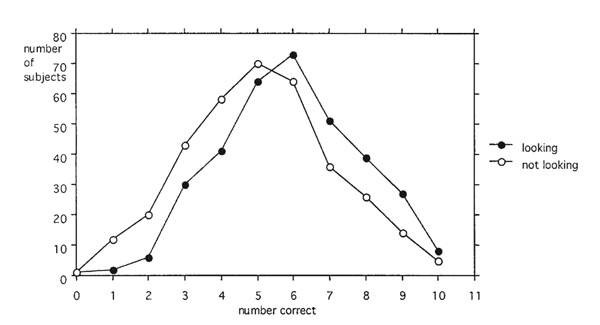
Figure 2. The distribution of scores in looking and not-looking trials in schools in Connecticut.18
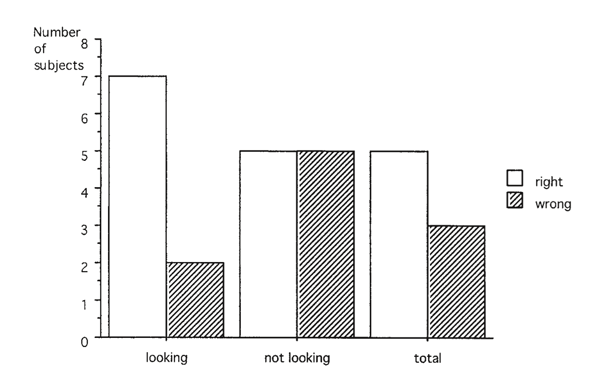
Figure 3. Results from the staring experiments of Coover (1913), showing the number of subjects who were more right than wrong compared with those who were more wrong than right.
However we choose to interpret it, this pattern of results is characteristic of direct-looking experiments. It even appears in the supposedly negative results of Coover19 when analysed by the sign method (Figure 3). This same pattern also appeared in an experiment that Colwell and colleagues carried out at Middlesex University20, with the subjects and starers separated by a one-way mirror (Figure 4). A recent replication by Dean Radin21 showed this same pattern again.
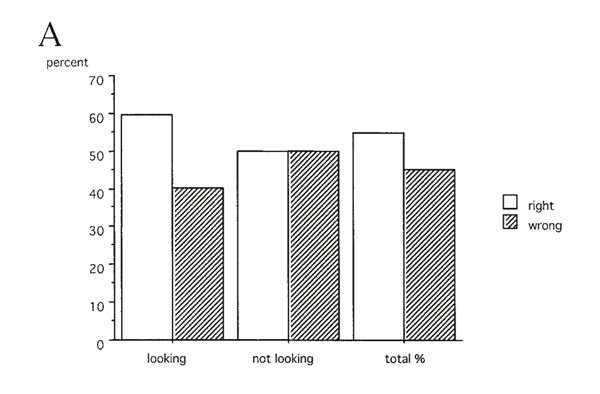
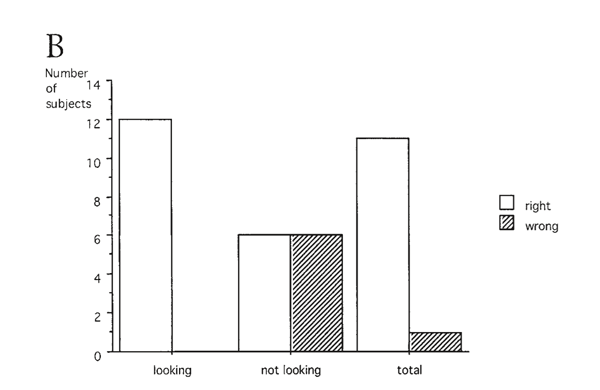
Figure 4. Results from the staring experiments of Colwell et al. plotted in the same way as in Figure 1.22
Possible Artifacts
Perhaps one or more artifacts underlie these repeatable positive results, such as Subjects saw whether they were being stared at or not by peeping or peripheral vision; Subtle sensory cues; Cheating; Hand scoring errors; Implicit learning.23 The available data go against these artifact hypotheses.
‘Real Life’ Experiments
The kinds of experiments discussed above are very artificial. In experiments in more natural conditions, people are watched by hidden observers. Do they turn round more than when they are not being watched?
The lookers are hidden behind a one-way mirror or darkened window that overlooks a public space. Close to the lookers, a video camera films this public space continuously. In a randomized series of one-minute trials, the lookers either stare at the backs of people in this public space or do not look. Later, the videotape is evaluated blind by a person not otherwise involved in the experiment. This evaluator scores how many people turn around and look towards the camera in each one-minute period.
Sheldrake carried out an experiment of this kind at the BBC Television Centre in London in which the subjects were waiting to go into a studio as a quiz show audience. They had their backs to the hidden lookers. There were six lookers altogether, who were invisible to the subjects because the office window was made of darkened glass and the lights in the office were switched off.
During the staring periods, the lookers quite often saw people turn around and look straight towards them. The video was analysed independently by a judge who did not know which one-minute periods were staring periods and which were not. There were significantly more turns during the staring periods than during the not-staring periods: 27 as opposed to 12.24
The same experimental method can be used with non-human subjects. Indeed, five students hid in bushes near a lake in Rome, from which they could watch resting geese on the shore through binoculars. The geese were filmed continuously. During the three-minute watching periods, each of the students observed a different goose, and in the three-minute non-watching periods they did not. An analysis of the video revealed that during the looking periods, on ten occasions geese woke up and looked towards the hidden observers, whereas in the not-looking periods this happened only three times.25
Very little research has so far been done under ‘real life’ conditions, but these preliminary experiments show that this experimental method is feasible with both people and animals.
Closed Circuit Television (CCTV) Experiments
Millions of CCTV cameras are used routinely for surveillance in shopping malls, banks, offices, airports, streets and other public spaces. A representative sample of surveillance officers and security personnel have been interviewed whose job is to observe people through CCTV systems. Sheldrake asked them about their experiences when watching people on the TV monitors. Most, but not all, were convinced that some people could tell when they were being watched, and gave examples to support this opinion.26
Controlled experiments corroborate this anecdotal evidence. Starting in the 1980s, several parapsychologists have done tests using CCTV, with the subjects and lookers in separate rooms. In these tests the subjects were not asked to guess whether they were being looked at or not. Instead, their galvanic skin response was recorded automatically, as in lie-detector tests. In a randomized series of trials the lookers either looked at the subject’s image on the TV monitor, or looked away and thought of something else.
Most of these experiments gave statistically significant positive results. The subjects’ skin resistance changed when they were being looked at, even though they were unconscious of this change.27 A recent meta-analysis of fifteen CCTV staring studies confirmed that there was an overall statistically significant positive effect.28
Sceptical Responses
There are several campaigning organizations devoted to debunking ‘claims of the paranormal’, but the most active, prestigious and effective is CSI (Committee for Skeptical Inquiry, formerly CSICOP, the Committee for the Scientific Investigation of Claims of the Paranormal). CSI’s publications include the Skeptical Inquirer magazine in the USA, and The Skeptic in Britain.
In response to the growing interest in the sense of being stared at, four CSI Fellows have recently investigated the phenomenon, namely Robert Baker, David Marks, Susan Blackmore and Richard Wiseman. So has Christopher French, the editor of The Skeptic. All five are academic psychologists. What have they found?
Robert Baker
In his first demonstration, Baker selected people who were engrossed in eating or drinking, watching TV, working at computer terminals or reading in the University of Kentucky library. He unobtrusively positioned himself behind them and stared at them for an average of 8.6 minutes. He then introduced himself and asked them to fill in a response sheet. Thirty-five out of forty people gave the expected response: ‘During the last five minutes I was totally unaware that anyone was looking at me’. Contrary to Baker’s prediction, two people reported that they had been aware that they were ‘being observed and stared at’ and three reported they felt something was ‘wrong’. Baker noted that while he was staring at the subjects who felt something was wrong, ‘All three stood up, looked around, shifted their position several times and appeared to be momentarily distracted on a number of occasions.’
Baker dismissed these unexpected findings. He argued that the three people who said something was wrong were not really affected by his staring, instead, he assumed that their restlessness was the cause of their feeling something was wrong. But this argument begs the question.
Baker also ‘discarded’ the results from the two people who said they knew they had been stared at. He regarded them as ‘suspect’ because one claimed he had extrasensory ability and the other claimed she was constantly being spied on.29 But if the sense of being stared at really exists, people who claim to have extrasensory abilities might be more sensitive than the average, and so might paranoid people.30
Baker then carried out a second demonstration in which he himself stared at subjects through a one-way mirror.31 The results were non-significant. But his experimental design was poor (e.g. scheduling three times as many non-looking trials than looking trials), and the instructions he gave to the subjects were ambiguous, confusing and self-contradictory.32 For more detail on these claims, see here.
David Marks
David Marks, a leading British sceptic, encouraged a fellow psychologist, John Colwell, to carry out a staring experiment in his laboratory at Middlesex University. Staring took place through a one-way mirror and Colwell and his colleagues tested the same subjects repeatedly. Subjects were given trial-by-trial feedback and improved with practice.33 The overall results were positive and very significant statistically, and showed a pattern similar to that in other tests (Figure 4).
In an article in the Skeptical Inquirer, Marks and Colwell (2000) tried to explain this unexpected result as an artifact of the randomization procedures. In their experiment, Colwell et al. (2000) used a set of 24 instruction sheets that were at that time provided on Sheldrake’s website. In response to a previous recommendation by sceptics,34 the randomization was counterbalanced on these particular sheets. Marks and Colwell speculated that rather than showing that people really can feel stares, their participants’ positive scores arose from ‘the detection and response to structure’ present in this set of randomized sequences. But they did not offer evidence that their participants did in fact learn to detect hidden structures in the randomization. By looking at the trial-by-trial scores, it would have been possible to see if there really was an excess of successful guesses as a result of any structure they chose to postulate. When Sheldrake offered to examine their data to test their hypothesis, they declined.
Even if subjects had learned implicitly to detect hidden structures in the randomization sequence, they should have improved in looking and not-looking trials. But this is not what happened. Scores improved only in the looking trials (Figure 4). Marks and Colwell did not mention this problematic feature of the data.
After their unexpectedly positive result, Colwell et al.(2000) did a second experiment using ‘structureless’ randomizations. This time the results were nonsignificant. They took this to confirm their implicit learning hypothesis. But in this second experiment there were two major differences - both a different randomization method and also a different looker, a colleague of Colwell’s. When Sheldrake raised the possibility of an experimenter effect,35 they dismissed it as ‘a red herring’.36 In fact experimenter effects are known to occur in staring tests, as discussed below.
Marks and Colwellentitled their Skeptical Inquirer article,37 ‘The psychic staring effect: an artifact of pseudo randomization.’ They claimed that Sheldrake’s results and those of other investigators were artifacts arising from the implicit learning of hidden patterns in this particular set of counterbalanced randomizations. But this hypothesis was contradicted by the facts. First, this set of randomizations was only used in some of Sheldrake’s tests, and in many thousands of his other tests there were different randomization methods. For example, in more than 5,000 trials the randomizations were provided by tossing coins, with highly significant positive scores.38 Their prediction was also contradicted by results from over 18,000 subjects in the NeMo experiment, where the computerized randomizations were ‘structureless’.
Second, the Marks and Colwell hypothesis predicted that the scores should be at chance levels in trials without feedback. But trials without feedback gave very significant positive results.39
Marks has strong beliefs and disbeliefs. He has quantified his disbelief in the sense of being stared as a probability of a million to one against.40 Two years after his exchange with Sheldrake in the Skeptical Inquirer, he reiterated his original arguments in The Skeptic,41 omitting any mention of the evidence that went against his implicit learning hypothesis.42
Christopher French
Neal Rattee, a student of Christopher French, carried out a CCTV staring experiment in French’s laboratory in 1996. He found that there was a difference between subjects’ responses in the looking and not-looking trials. Was this difference statistically significant at the conventional p = 0.05 level? No, according to a two-tailed combined t-test (p = 0.096). Yes, if a one-tailed test were used (p = 0.048). Sheldrake asked Rattee and French if he could analyse their data using other statistical tests, but unfortunately this was not possible because they had discarded the data.
Richard Wiseman
In initial experiments using the CCTV method in Richard Wiseman’s laboratory there was a statistically significant positive effect.43
Wiseman and Smith then went back over their data to look for a possible flaw to account for this. They found that in their randomizations more looking trials preceded not-looking trials than vice versa. They argued that this could have given rise to an artifactual positive result if subjects’ galvanic skin resistance (GSR) declined throughout the session as they became more relaxed. They did not examine their data to see if this was in fact the case. They took it for granted that their hypothesis was correct.
Sheldrake asked Wiseman if he could analyse the data to test their hypothesis. At first Wiseman told Sheldrake that the results were inaccessible, but Wiseman finally managed to retrieve the data for seventeen out of thirty subjects. He then sent them to Sheldrake, who found that in ten cases GSR declined throughout the test session, while in seven it increased. The available facts did not support the Wiseman-Smith hypothesis.
In Wiseman and Smith’s initial experiments, students served as starers. In subsequent CCTV experiments, Wiseman changed the procedure so that the experimenters themselves did all the looking. The results were then at chance levels.44
There could arguably be an experimenter expectancy effect when experimenters themselves serve as lookers. Experimenter expectancy effects are widely recognized in experimental psychology; experimenters tend to get results that confirm their expectations,45 which is why many psychological experiments and clinical trials are carried out blind or double blind.
This possibility of an experimenter effect has been tested directly by Wiseman and Marilyn Schlitz, who jointly carried out a CCTV staring experiment in which half the subjects were tested with Schlitz as experimenter and looker, and half with Wiseman. As on previous occasions,46 Schlitz obtained significant positive results, while Wiseman’s results were nonsignificant.47
Such experimenter effects are not symmetrical. The detection of Schlitz’s stares by the participants implies the existence of an unexplained sensitivity to stares. The failure of subjects to detect Wiseman’s stares may imply only that Wiseman was an ineffective starer. He later said that he found staring ‘an enormously boring experience’ and that in most of the trials he was ‘pretty passive about it’.48
Interestingly, the research initiated by all four CSI Fellows, Robert Baker, David Marks, Susan Blackmore and Richard Wiseman, gave positive results to start with. Baker, Marks and Wiseman then reacted to their positive findings in a similar way. First they tried to dismiss the results as artifacts. Then in follow-up experiments, they themselves, or their colleagues, did all the staring, achieving the non-significant results they expected.
By contrast, in the vast majority of tests by other investigators, the experimenters acted only as coordinators; the participants served as both starers and lookers. Under these conditions the results were overwhelmingly positive.
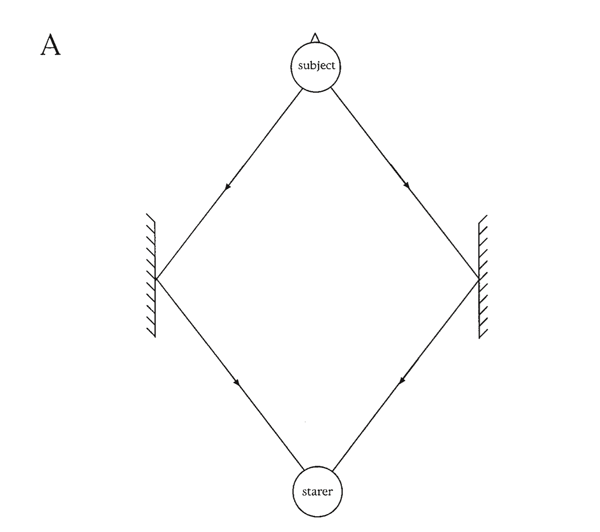

Figure 5. Diagrams showing the positions of starers and subjects in experiments involving mirrors, with rays indicating the reflection of light.
A (Above): The starer looks at the subject through a mirror on the left or on the right. The subject guesses which side the look is coming from.
B (Below): The starer looks at the back of the subject through a mirror in a doorway.
Open Questions
Most of the available evidence implies that the sense of bring stared at is real. Given that the evidence is strong enough to merit further research, a series of new questions arise that can only be answered empirically. These are:
1. Does the sense of being stared at work through mirrors?
2. Is the sense of being stared at directional?
3. Can people tell who is staring?
4. Does the sense of being stared at work on television?
5. Can people tell when looks begin and end?
6. How sensitive are animals to being stared at?
7. Can people get better with practice?
8. What kinds of people are most effective as lookers, or most sensitive as subjects?
9. Do several starers have more effect than one?
10. Does the distance between the starer and the subject make much difference?
(For a more detailed discussion of these questions, see Sheldrake (2005:28).
The reason for these questions having not been investigated as of yet is mainly to do with the taboo nature of the subject in the scientific community and, indeed, the wider public. This aversion arises from the materialist worldview, conventional vision theory, and dismissal of “superstitions” like the Evil Eye, rather than experimental difficulty or expense.
Conclusions
The reality of the sense of being stared at is strongly supported by experimental research. Sceptics’ attempts to refute this research have failed, and some skeptics have obtained positive results in their own experiments. Gazes can still be detected when they have passed through windows and one-way mirrors. Looking at people affects them even through closed-circuit television, even when they are unconscious of being looked at. Preliminary results suggest that people can tell when they are being looked at through a mirror, and can detect from which direction they are being watched, in agreement with real-life experiences.
Rupert Sheldrake
Literature
Baker, R. (2000). Can we tell when someone is staring at us from behind? Skeptical Inquirer (March/April), 34–40.
Baker, R. (2001). Robert Baker replies to Sheldrake.Skeptical Inquirer (March/April), 61.
Braud, W., Shafer, D., & Andrews, S. (1990). Electrodermal correlates of remote attention: Autonomic reactions to an unseen gaze. Proceedings of Presented Papers, Parapsychology Association 33rd Annual Convention, Chevy Chase, Maryland, 14–28.
Braud, W., Shafer, D., & Andrews, S. (1993a). Reactions to an unseen gaze (remote attention): A review, with new data on autonomic staring detection. Journal of Parapsychology 57, 373–90.
Braud, W., Shafer, D,. & Andrews, S. (1993b). Further studies of autonomic detection of remote staring: Replications, new control procedures, and personality correlates. Journal of Parapsychology 57, 391-409.
Colwell, J., Schröder, S, & Sladen, D. (2000). The ability to detect unseen staring: A literature review and empirical tests. British Journal of Psychology 91, 71–85.
Conan Doyle, A. (1884). J. Habakuk Jephson’s statement. Cornhill Magazine, January.
Coover, J.E. (1913). The feeling of being stared at — experimental. American Journal of Psychology 24, 570–5.
Corbett, J. (1986). Jim Corbett’s India. Oxford, UK: Oxford University Press.
Cottrell, J.E., Winer, G.A., & Smith, M.C. (1996). Beliefs of children and adults about feeling stares of unseen others. Developmental Psychology 32, 50–61.
Delanoy, D. (2001). Anomalous psychophysiological responses to remote cognition: The DMILS studies. European Journal of Parapsychology 16, 30–41.
Lindberg, D.C. (1981), Theories of Vision from Al-Kindi to Kepler. Chicago, Illinois, USA: University of Chicago Press.
Lobach, E., & Bierman, D.J. (2004). The invisible gaze: Three attempts to replicate Sheldrake’s staring effects. Proceedings of Parapsychology Association Annual Convention, 2004.
Long, W.J. (1919). How Animals Talk. New York: Harper.
Marks, D. (2002). The Psychology of the Psychic (2nd ed). Amherst, New York, USA: Prometheus Books.
Marks, D. (2003). What are we to make of exceptional experience? Part 3: Unseen staring detection and ESP in pets. The Skeptic 16, 8–12.
Marks, D., & Colwell, J. (2000). The psychic staring effect: An artifact of pseudo randomization. Skeptical Inquirer (September/October), 41–49.
Marks, D., & Colwell, J. (2001). Fooling and falling into the sense of being stared at. Skeptical Inquirer (March/April), 62–63.
Peterson, D.M. (1978). Through the looking glass: An investigation of the faculty of extra-sensory detection of being looked at. Unpublished MA thesis, University of Edinburgh.
Poortman, J.J. (1939). Het hegemonikon en zijn aandacht van den tweeden graad. Tijdschrift voor Parapsychologie 11, 97–120 [In Dutch].
Poortman, J.J. (1959). The feeling of being stared at. Journal of the Society for Psychical Research 40, 4–12.
Radin, D. (2004). The feeling of being stared at: An analysis and replication. Journal of the Society for Psychical Research 68, 245–52.
Rosenthal, R. (1976). Experimenter Effects in Behavioral Research. New York: John Wiley.
Schlitz. M., & Braud, W. (1997). Distant intentionality and healing: Assessing the evidence. Alternative Therapies 3, 62–73.
Schlitz, M.,. & LaBerge, S. (1994). Autonomic detection of remote observation: Two conceptual replications. Proceedings of Presented Papers, Parapsychology Association 37th Annual Convention, Amsterdam, 352–60.
Schlitz, M., & LaBerge, S. (1997). Covert observation increases skin conductance in subjects unaware of when they are being observed: a replication. Journal of Parapsychology 61, 185–95.
Schmidt, S. (2001). Empirische Testung der Theorie der morphischen Resonanz: Können wir entdecken wenn wir angeblikt werden? Forschende Komplentärmedizin 8, 48–50.
Schmidt, S., Schneider, R., Utts, J., & Walach, H. (2004). Distant intentionality and the feeling of being stared at: Two meta-analyses. British Journal of Psychology 95, 235–47.
Sheldrake, R. (1994). Seven Experiments that Could Change the World. London: Fourth Estate.
Sheldrake, R. (1996). An experiment with birds. Uccelli/Birds Zerynthia, Rome.
Sheldrake, R. (1998). The sense of being stared at: Experiments in schools. Journal of the Society for Psychical Research 62, 311–23.
Sheldrake, R. (1999). The “sense of being stared at” confirmed by simple experiments. Biology Forum 92, 53–76.
Sheldrake, R. (2000). The “sense of being stared at” does not depend on known sensory clues. Biology Forum 93, 209–24.
Sheldrake, R. (2001a). Experiments on the sense of being stared at: The elimination of possible artifacts. Journal of the Society for Psychical Research 65, 122–37.
Sheldrake, R. (2001b). Research on the sense of being stared at. Skeptical Inquirer March/April, 58–61.
Sheldrake, R. (2002). The sense of being stared at: An experiment at Holma College. Gränsoverskridaren 10, 21–3.
Sheldrake, R. (2003a/2013). The Sense of Being Stared At, And Other Aspects of the Extended Mind. London: Hutchinson/Rochester: Park Street Press.
Sheldrake, R. (2003b). The need for open-minded scepticism: A reply to David Marks. The Skeptic 16, 8–13.
Sheldrake, R. (2005). The sense of being stared at. Journal of Consciousness Studies 12/6, 10–31.
Titchener, E.B. (1898). The feeling of being stared at. Science New Series 8, 895–97.
Watt, C., Wiseman, R., & Schlitz, M. (2002). Tacit information in remote staring research: The Wiseman-Schlitz interviews. The Paranormal Review 24,18–25.
Williams, L. (1983). Minimal cue perception of the regard of others; The feeling of being stared at. Journal of Parapsychology 47, 59–60.
Wiseman, R., & Schlitz, M (1997). Experimenter effects and the remote detection of staring. Journal of Parapsychology 61, 197–207.
Wiseman, R., & Smith, M.D. (1994). A further look at the detection of unseen gaze. Proceedings of the Parapsychological Association 37th Annual Convention, Parapsychological Association, 465–78.
Wiseman, R., Smith, M.D., Freedman, D., Wasserman, T., & Hurst, C. (1995). Examining the remote staring effect: two further experiments. Proceedings of Presented Papers, Parapsychology Association 38th Annual Convention, Parapsychological Association, 480–90.
Endnotes
- 1. Braud et al. (1990); Sheldrake (1994); Cottrell et al. (1996).
- 2. Sheldrake (2003a/2013).
- 3. Sheldrake (2003a/2013).
- 4. Corbett (1986); Sheldrake (2003a/2013).
- 5. Cottrell et al. (1996).
- 6. Sheldrake (1999).
- 7. e.g., Marks (2003).
- 8. Coover (1913).
- 9. Poortman (1959); statistical analysis in Sheldrake (1994), chapter 4.
- 10. Williams (1983).
- 11. Sheldrake (2003a).
- 12. Sheldrake (1998).
- 13. Thus, for example, 2000 refers to Sheldrake (2000).
- 14. Sheldrake (2001a).
- 15. Sheldrake (2003a).
- 16. Sheldrake (2003a).
- 17. For a discussion of Schmidt’s challenge to this interpretation of the results and Sheldrake’s response, see Sheldrake (2005).
- 18. Sheldrake (1999).
- 19. Coover (1913)
- 20. Cowell et al. (2000).
- 21. Radin (2004).
- 22. Data from Table 1 of Colwell et al., 2000, for trials in which subjects were given feedback.
- 23. For Sheldrake’s discussion of each of these, see Sheldrake (2005:21).
- 24. Sheldrake (2003a).
- 25. Sheldrake (1996).
- 26. Sheldrake (2003a).
- 27. Braud et al. (1990; 1993a,b); Schlitz & LaBerge (1994;1997); Schlitz & Braud (1997); Delanoy (2001).
- 28. Schmidt et al. (2004).
- 29. Baker (2000).
- 30. Sheldrake (1994).
- 31. Baker (2000).
- 32. Sheldrake (2001b); Baker (2001).
- 33. Colwell et al.(2000).
- 34. Wiseman & Smith (1994).
- 35. Sheldrake (2001b).
- 36. Marks and Colwell (2001).
- 37. Marks & Colwell (2001).
- 38. Sheldrake (1999).
- 39. Sheldrake (2000).
- 40. Marks (2000).
- 41. Marks (2003).
- 42. Sheldrake (2003b).
- 43. Wiseman & Smith (1994).
- 44. Wiseman et al.(1995).
- 45. Rosenthal (1976).
- 46. Schlitz & LaBerge (1994; 1997).
- 47. Wiseman & Schlitz (1997).
- 48. Watt et al. (2002).

